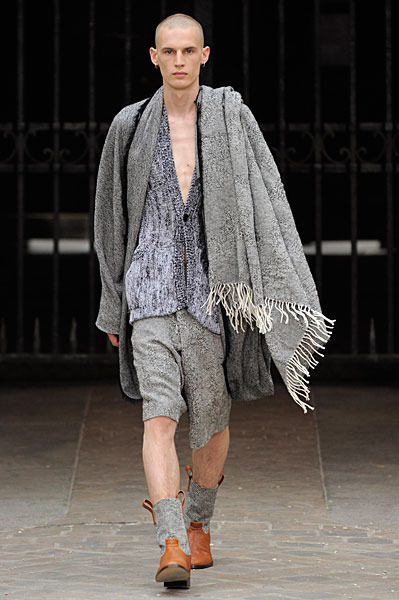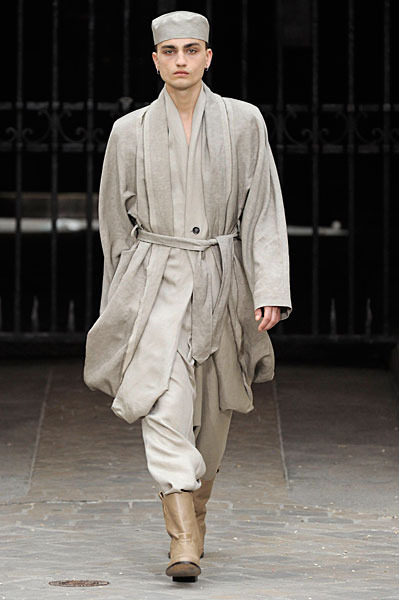I'm Coming Home
Spring/Summer 2011
The Spring/Summer 2011 collection by Damir Doma is one of my favourite collections in recent memory (I may do a post on the latest Autumn/Winter 2011 collection in the near future). Drawing inspiration from historical Turkish and Ottoman dress, it was a collection confidently reinventing the Classical through Damir's contemporary and avant-garde lens. I have a severe dislike for how the fashion media seem to latch onto the term "Ethnic" (or "Oriental" and "Safari" for that matter), using it to separate that, which does not easily conform to the traditional Western Canon, into the realm of the exotic Other. It is a term that has been guiltlessly applied to this collection, which may be understandable for most, however for me is odd, because I do not see an 'Other' - I see my self.
I see loose and easy silhouettes, blanket shawls, pillbox hats, shorts reminiscent of dhotis, and a range of what I would consider 'traditional', for want of a better word, references that immediately evoke memories and emotions from my childhood and background. I can imagine my father as a young man quite comfortably wearing these in another life, and it is that implicit connection to something deep and personal within you that makes this collection so...I want to say important? To paraphrase Wim Wenders it is as if the designer sees something in you that is more you than you - you find yourself wondering what secret the designer has unlocked about you.
I suppose the easiest analogy to make, in terms of my reaction to the referencing, would be that of a Japanese audience looking at the work of Yohji Yamamoto. Although he works within the framework of traditional Western (by which I mean European) tailoring, he approaches it with a firm Japanese aesthetic and philosophy - not to mention his insistence on Japanese manufacturing techniques, for to Yohji, 'Made In Japan' really does mean something. That relationship of a Japanese mindset and culture to the work of Yohji is perhaps difficult for those born and raised on the other side of the world to appreciate. I am not saying that you require to understand every cultural nuance, if any at all, because fashion speaks directly and intimately to the individual - what I see in a collection is personal to my own life, memories and emotions. However the disparity, as well as the overlaps, in how I and others react and relate to a certain garment or collection really does fascinate me.
Indeed I always find it interesting to consider what those with a more intimate connection to the references may see - does it ever verge into the realm of costume? You would perhaps think that those from a culture that is being referenced must see costume, for when Ralph Lauren does 'Safari' or the Parisians do 'Oriental', I see just that. However in terms of Damir Doma's work, I do not see costume - I merely see references to my own cultural background and I appreciate and intimately respond to that. Paradoxically to the other scenarios given, perhaps it is in this case the non-identified, or better yet the non-referenced, that sees costume. If that is the case what divides the two instances? Although disconnect - that of the designer against the culture referenced - is perhaps the obvious answer, there is something beyond that. Doma is Croatian-born and raised in Germany, so the referencing is not exactly direct to his own background in the same manner that Yohji's work covers. I want to say sincerity - a term that can often feel vacuous when applied to fashion, however here it is what I see and what I feel when I handle and try on the clothing.
It is the view of the outsider, one removed from what is referenced, that can perhaps be the most artistic - for when within it is hard to distill the essence and find those overarching references. They can be obscured and hidden by virtue of their utter normality. But then some sense of intimacy and understanding is required, for without that it is not fully realized, and to use that odd phrase again, it is perhaps not as sincere. I think that would be the difference between a mere surface decoration and mimicry, over a true(r?) reinvention and referencing.
I responded to this collection in a personal way that is hard to describe. Suffice to say that I saw it and somehow it was as if in that moment Damir understood me and I understood him. It is for me that rare moment which makes fashion magical. A special thanks to those who read this post in its entirety, I fear you may be in the minority, but I would hug each and every one of you if I could.
The man himself
I read an interview with Damir from Paper Planes Magazine a while back and I saved two quotes I rather liked that I thought I would share.
On designing womenswear:
"At the moment my inspiration comes from my girlfriend – I’m doing the clothes for her."
The best way to do it if you ask me. Yohji's daughter says that her father designs around the women he is dating at the time - it is a world of fantasy. Similarly Ann Demeulemeester designed expressly for women, however started designing menswear after her husband asked her to make men's versions of certain pieces.
On London Fashion Week:
"That’s London’s image. That’s what London is trying to be. But to me it’s all very calculating, because creativity does not just mean being ‘crazy’. Creativity is a bit more than that. You need direction; you need structure; you need a voice and you need to have something to say…London sometimes gets these things mixed up; they confuse creation for creation’s sake with being really creative."
This really intrigued me because it is a view that has been relevant for some time now with regards to London Fashion Week - are we still in the shadow of McQueen and Chalayan of the '90s? Even a contemporary example such as Gareth Pugh is an exception, for let us not forget, he lived in a squat and did not actually sell anything from the first few collections - it was Michelle Lamy (wife of Rick Owens) and Paris that gave him the security and opportunity to sell. I think many designers fresh out of university feel the need to show, and London is the only place where that is really possible, however it is not always really in their best interests. How many times have we seen a designer show and then just disappear? Either gobbled up by the high street or simply not having the backing or understanding to build a label. I fear this debate is a can of worms that really deserves a series of posts of its own, so I shall leave it there.
P.S. I made it onto the Most Wanted Fashion 100 list for the second year running - so thank you.
P.S. I made it onto the Most Wanted Fashion 100 list for the second year running - so thank you.
xxxx













